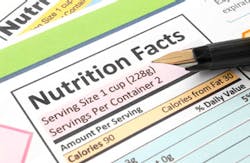First Lady Michelle Obama joined Secretary of Health and Human Services Kathleen Sebelius and U.S. Food and Drug Administration (FDA) Commissioner Margaret Hamburg at the White House on Feb. 27 to announce proposed revisions to the Nutrition Facts label, which has been significantly updated only once since its initial release 20 years ago.
The proposed changes will bring the familiar rectangular box, which is featured on roughly 700,000 products, up to date with changes to its design and content, according to the FDA.
The proposed updates are intended to reflect the latest scientific information about the link between diet and chronic diseases such as obesity and heart disease. The proposed label would also replace out-of-date serving sizes to better align with the amount consumers actually eat, and it would feature a fresh design to highlight key parts of the label such as calories and serving sizes.
RELATED: FDA presents new draft rule on safe food transportation
“Our guiding principle here is very simple: that you as a parent and a consumer should be able to walk into your local grocery store, pick up an item off the shelf, and be able to tell whether it’s good for your family,” said Obama. “So this is a big deal, and it’s going to make a big difference for families all across this country.”
Changes include:
- Greater emphasis — with larger and bolder type — would be placed on calories.
- "Added Sugars" would be added.
- "Calories from Fat" would no longer be included because the type of fat is more important than the total amount.
- Number of servings per package would also be more prominent.
- FDA would update Daily Values for various nutrients. Daily Values are used to calculate the Percent Daily Value (%DV) on the label, which helps consumers understand the nutrition information in the context of a total diet.
- The amounts of potassium and Vitamin D would be required on the label.
"The goal is to make people aware of what they are eating and give them the tools to make healthy dietary choices throughout the day," said Jessica Leighton, Ph.D., senior nutrition science and policy advisor in FDA's Office of Foods and Veterinary Medicine.
